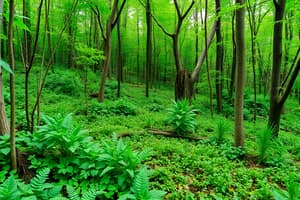Podcast
Questions and Answers
Which of the following best describes the biotic part of an ecosystem?
Which of the following best describes the biotic part of an ecosystem?
- Temperature and soil
- Rocks and minerals
- Water and air
- Plants and animals (correct)
What is an example of abiotic factors in an ecosystem?
What is an example of abiotic factors in an ecosystem?
- Different species populations
- Predation and cooperation
- Competition among species
- Soil composition and climate (correct)
How do abiotic factors influence the organisms in an ecosystem?
How do abiotic factors influence the organisms in an ecosystem?
- They enhance organism competition.
- They increase biodiversity.
- They dictate the food chain structure.
- They determine which plants and animals can survive. (correct)
What is meant by limiting factors in an ecosystem?
What is meant by limiting factors in an ecosystem?
Which statement is true about ecosystems with high diversity?
Which statement is true about ecosystems with high diversity?
What is one effect of human activities on ecosystems?
What is one effect of human activities on ecosystems?
What does standing in the middle of an open field represent in ecological terms?
What does standing in the middle of an open field represent in ecological terms?
What role do plants play in determining the health of an ecosystem?
What role do plants play in determining the health of an ecosystem?
Flashcards
Ecosystem
Ecosystem
A community of living (biotic) and non-living (abiotic) things interacting in a particular area.
Biotic factors
Biotic factors
The living parts of an ecosystem, such as plants and animals.
Abiotic factors
Abiotic factors
The non-living parts of an ecosystem, such as temperature, water, and soil.
Populations
Populations
Signup and view all the flashcards
Communities
Communities
Signup and view all the flashcards
Limiting factors
Limiting factors
Signup and view all the flashcards
Ecosystem diversity
Ecosystem diversity
Signup and view all the flashcards
High Diversity, High Competition
High Diversity, High Competition
Signup and view all the flashcards
Study Notes
Ecosystem Basics
- An ecosystem combines biotic (living) and abiotic (non-living) components.
- Biotic parts include plants, animals.
- Abiotic parts include temperature, water, soil, and air.
Populations in an Ecosystem
- A population consists of all organisms of the same species in a specific area.
- Communities are groups of different populations within an ecosystem.
- Organisms occupy different niches in the same environment.
- Similar niches can lead to competition due to shared resources.
Ecosystem Diversity and Health
- High biodiversity provides more resources.
- Biodiversity helps resources last longer.
- Less diverse ecosystems have reduced competition.
- South American rainforests display a strong relationship between ecosystem diversity and health.
Abiotic Factors in Ecosystems
- Abiotic factors like temperature, water, soil, and air influence an ecosystem.
- These factors affect which species can survive and thrive.
- Abiotic factors affect the rate of seasonal changes and the communities present.
- Abiotic factors directly affect how humans can influence ecosystems.
Limiting Factors of Ecosystems
- Limiting factors restrict population size.
- Limiting factors include resources, space, and predators.
- Limiting factors influence plant and animal development and growth.
- Limiting factors include animal maturity rates.
Studying That Suits You
Use AI to generate personalized quizzes and flashcards to suit your learning preferences.




